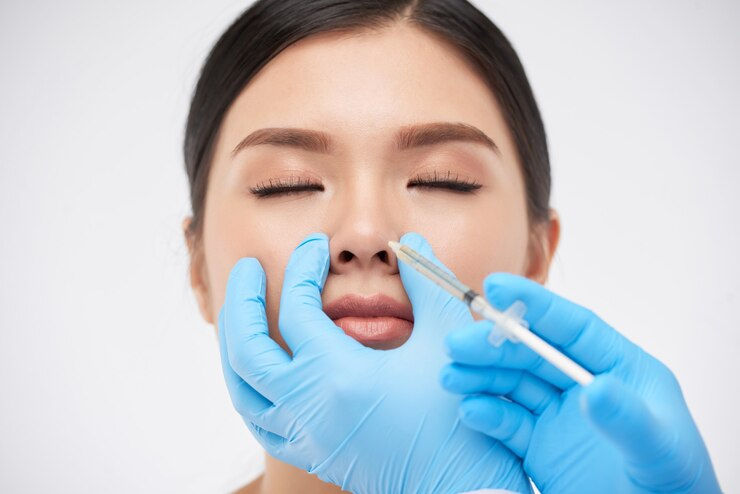Smiling After Rhinoplasty: What to Expect
- Royal Clinic
- May 9
- 4 min read
Rhinoplasty, commonly referred to as a nose reshaping procedure, can have a notable impact on both facial appearance and expressions. One of the most common questions individuals have following the procedure is, “When can I smile normally again?” Understanding the changes, expectations, and timeframe for smiling after rhinoplasty helps manage post-procedure experiences confidently. let's delve into Rhinoplasty Dubai
Understanding the Connection Between Rhinoplasty and Smiling:
Facial expressions, including smiling, rely on a complex network of muscles. During rhinoplasty, especially when the tip or base of the nose is altered, some of these muscles can be affected, either directly or through temporary swelling. This may result in a sensation of tightness or stiffness around the upper lip and nose area when attempting to smile.
Why Smiling Feels Different After the Procedure:
It's common to feel that your smile has changed immediately after surgery. This isn’t typically due to a permanent change in your muscles, but rather the result of:
Swelling in the cheeks and upper lip
Temporary numbness
Minor trauma to soft tissues around the nose
Stitches or support in the nasal base
As these factors gradually resolve, the ability to smile naturally usually returns.
The First Few Days: Adjusting to Changes:
In the initial days following the procedure, most individuals are advised to limit expressive facial movements. This includes smiling, laughing, or any gestures that place strain on the nasal and upper lip region.
During this period, facial movements may feel restricted or uncomfortable, but this is a normal part of the recovery process. Even small expressions might feel unnatural due to the presence of bandages or internal swelling.
Swelling and Its Effect on Facial Expression:
Swelling is most pronounced in the first week and can affect the way your upper lip moves. This may make your smile look uneven or subdued. Rest assured, these changes are temporary and will gradually diminish over time.
Weeks Following the Procedure: What to Expect:
By the end of the first or second week, significant swelling begins to subside. Although the smile may still feel somewhat tight, many individuals notice improvement in movement and control.
Subtle Facial Stiffness Persists:
It’s not unusual for subtle tightness to persist for several weeks. This doesn’t mean anything is wrong—it’s simply part of the healing process. The nasal tip, in particular, can feel rigid or numb, which can limit natural facial movement.
Return of Upper Lip Mobility:
The upper lip plays a key role in smiling. As tissues recover and sensation gradually returns, the lip becomes more mobile, allowing your smile to feel more natural again. This tends to improve significantly within the first month.

Long-Term Smile Recovery: A Natural Return:
By the two-to-three-month mark, most individuals notice that their smile feels almost back to normal. In many cases, the smile looks even better due to the improved balance of facial features following the nose reshaping.
Gradual Normalization:
The body continues to heal and refine its structure for several months. While swelling reduces significantly within the first few weeks, it may take up to a year for all minor internal changes to fully settle. This means small changes in how your smile feels or looks may continue to evolve, especially as scar tissue softens.
Facial Expression Awareness During Healing:
During the recovery period, it’s natural to become more aware of how your smile feels and looks. Minor differences that previously went unnoticed may become more prominent to you. This heightened self-awareness often fades as confidence returns and healing progresses.
Confidence and Patience Go Hand-in-Hand:
Many individuals feel self-conscious about smiling too broadly in the early weeks. Practicing patience and allowing the body time to heal without rushing expressions is key. Gradually, the smile regains its full movement, and the subtle refinements from the procedure can enhance the overall harmony of the face.
Smiling in Photos: Before and After:
Photographs taken shortly after the procedure may not reflect your true smile. Due to swelling and reduced mobility in the upper lip, expressions can appear muted or slightly off. As recovery advances, photo results become more aligned with your natural appearance, often showing an improved sense of balance and proportion.
Timeline for Returning to Photogenic Confidence:
Most individuals feel comfortable being photographed with a full smile again by the second or third month. Over time, the final shape of the Nose Job in Dubai and the relaxed movement of facial muscles work together to restore a confident, expressive look.
Exercises and Gentle Movements (Non-Therapeutic):
While no specific exercises are necessary, gently engaging in normal facial movements—like talking, smiling, or laughing—within comfort limits can gradually help the tissues adjust and regain flexibility. Over time, these small, natural gestures contribute to overall recovery.
Emotional Impact of Smiling Again:
Smiling is not only a physical act but also an emotional one. The ability to smile confidently again can enhance self-esteem and emotional well-being. As healing progresses, many people find that their enhanced facial harmony brings a renewed sense of joy and positivity to their expressions.
A Reassuring Process:
Knowing that smile changes are typically temporary provides peace of mind. Most individuals experience a smooth transition back to normal expression, with no lasting limitations.
Final Thoughts:
The journey back to smiling after rhinoplasty is a gradual process. Though it may feel different in the early stages, it is overwhelmingly temporary. With time, the smile not only returns but often complements the improved facial structure achieved through the procedure. Patience, understanding, and trust in the healing process are essential in embracing this transformation.





Comments